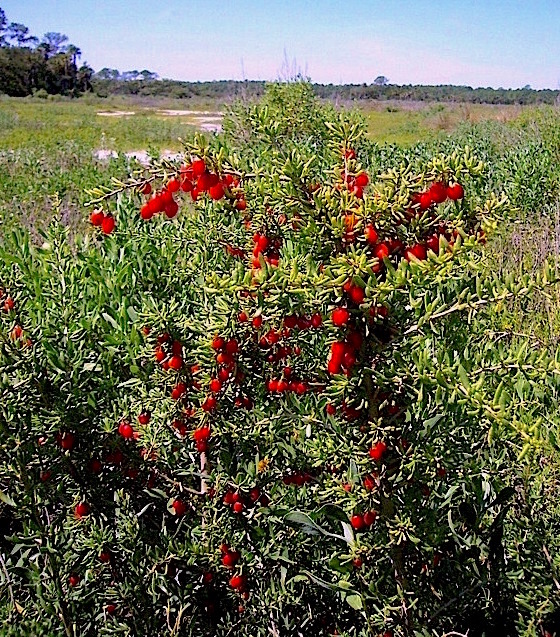
Goji Berry season will be starting soon. Photo by Green Deane
Editor’s Note: The first EatTheWeeds newsletter was written just before Thanksgiving, 2007. It was monthly back then. I rode my bike on the Seminole-Wekiva Trail and wrote about the edible plants there. I’m still riding my bike on the though the trail is now twice as long… and the goats are gone. You can read that original long newsletter here.
The seasons are changing and so is the foraging with a shift into not only fall but winter plants. This locally includes some spring and summer plants found in northern climates. Perhaps the prettiest sighting this past week was blossoming Christmasberries. There are several “Christmasberries” but this one in particular is our local Goji Berry (yes, it is edible.) It’s an odd shrub in the Nightshade family that likes brackish water. All the specimens I have found are coastal but usually on the inland water ways that have some tidal influence. They also tend to collect a lot of lichen often Ramlina and or Usnea. We saw them in bloom during a foraging class at Haulover Canal. They are common in Spruce Creek Park in Port Orange, FL., and across U.S. Highway One in the Doris Leeper Spruce Creek Preserve. They are also on the west side of Turtle Mound (there is a southside trail at low tide one can follow to the west side.) You can watch my video on them here and read my article here.
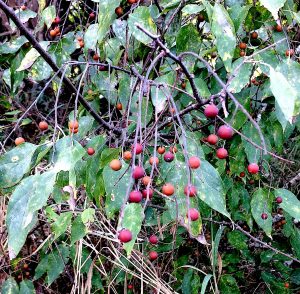
Sugarberries ripen from green to burnt orange sometimes slightly red. Photo by Green deane
Sugarberries are one of those “did they really collect this?” fruits. Are they tasty? Yes. Nutritious? Yes. Easy to identify? Yes. So what’s the problem? There are two: The berries can be rather sparse on the tree and the tree tends to be very tall. But that might be a twenty-second century perspective. Very few of us forage full-time and in the distant past foraging all the time was the main occupation. So in the past the tall, thinly fruited tree might not have been seen as a questionable resource but rather an esteemed one. Sugarberries, also called hackberries, have four fairly easy identifying characteristics. They can be large trees usually growing near water but not in it. This is also not a species you will find on the top of a hill unless there is a lake or spring there or good irrigation. It’s usually found in the company of sweet gums, pecans, ash, cedars and what is left of elms (whose family it is in.) The bark of older trees is very warty but no thorns. Sugarberry leaves usually have uneven shoulders and if you flip the leaf over there are thee main veins at the base. Edible raw or cooked, the berries are sweet, the kernel inside tasty but slightly hard to crack. Be careful of your teeth. Natives often mashed the entire fruit — seed and pulp — making them into small cakes to be eaten raw or cooked. When “sweet” was rare perhaps the tree was special rather than a harvesting pain. The odd second name “Hackberry” is thought to come from the Scottish “hagberry” which means “marsh berry” (but was in reference to related species that likes similar damp habitats.) You can read about the sugarberry here.
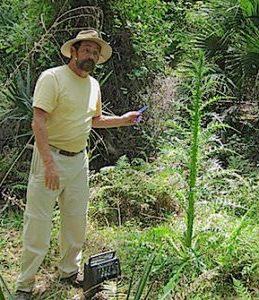
Foraging classes are held rain, shine, hot or cold. Photo by Nermina Krenata
Foraging Classes: With nicer weather in store my foraging classes range from Orlando to Sarasota this weekend. We look for wild edibles — luck of the seasonal draw — and identify them, mention culinary, medicinal uses and history.
Saturday, November 24th Blanchard Park, 10501 Jay Blanchard Trail, Orlando. 9 a.m. to noon. Meet next to the tennis courts by the YMCA building.
Sunday, November 25th, Red Bug Slough Preserve, 5200 Beneva Road, Sarasota, FL, 34233. 9 a.m. to noon. Meet at the entrance of the park.
Saturday, December 1st, Wickham Park: 2500 Parkway Drive, Melbourne, FL 32935-2335. 9 a.m. to noon. Meet at the “dog park” inside the park.
Sunday, December 2nd, Bayshore Live Oak Park, Bayshore Drive. Port Charlotte. 9 a.m to noon, meet at the park across from Ganyard Street.
Saturday, December 8th, Florida State College, south campus, 11901 Beach Blvd., Jacksonville, 32246. 9 a.m. to noon. We will meet at building “D” next to the administration parking lot.
Sunday, December 9th, this class will probably be in Largo, Florida, but at a different location than mentioned below.
To read more about the foraging classes go here.
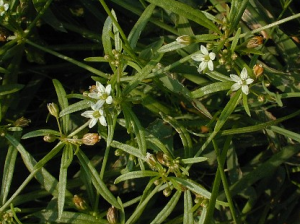
Carpetweed, an edible always under foot.
One of the more common edible weeds underfoot in North America is Carpetweed, Mollugo verticillata. Scraggly if not scrawny the wispy plant does have the saving grace that it is all edible, raw or cooked and it requires very little cooking. Add it last. There are several non-edible species that can resemble it so there are some of key points to remember. First, it does not have any white sap, it grows in a circular mat, and the blossoms have five white sepals but usually only three stamens, sometimes four or five but usually three, which is a bit odd for a five-sepal plant. Look for it in dry, sandy locations including waste ground. For all of its wide-spread presence in North America it is actually native to the tropical Americas. You can read about Carpetweed here.
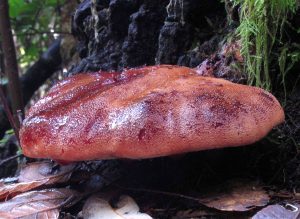
Beefsteak Polypore, Fistulina hepatica.
The Beefsteak Polypore should have been called the Raw Liver Polypore. (Yes, it also grows in warm Florida.) “Polypore” means many pores and this edible mushroom has many slightly strange pores: They are all separate, little tubes, not holes as many polypores are but a huge bunch of little tubes (think small straws tied in a bundle.) The mushroom can giggle like raw liver and spills a red juice when cut. But there the comparisons end, almost. It’s white streaked flesh can be cut like liver but it does not taste like liver. Its flavor is more on the acidic side and blends in well with dishes made with lemons. And while current advice is not to eat any mushrooms raw — including those you buy in the grocery store — this is one fungus that is consumed raw, with or without pores. The prohibition against raw mushrooms arises from two characteristics. One is the polysaccharide chitin or in this case mycochitin. Some people have the enzyme to digest it, some don’t. Undigested chitin can cause unpleasant digestive upset. The other issue is many raw mushrooms tend to have hydrazines, a class of chemicals known to cause cancer. Cooking drives off the hydrazines. And more than a few mushroom … ah… hunters have gotten nematodes from eating raw mild-altering mushrooms growing in manure. Cook your mushrooms. Indeed, some of the most prized of wild mushrooms will make you ill if consumed raw including Morels, Chanterelles, Oysters, and King Boletes. Do not confuse with the smaller and only-known toxic polypore Hapalopilus nidulans.
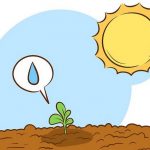 EatTheWeeds has been existing now almost 14 years. Thank you for your donations. There are always things to improve such as the indexing of these newsletters and making the search function more intelligent. As it is now I sometimes have a hard time finding an article I wrote! My webmaster is part time, which means now and then. There’s always something and such things get more complex and expensive every year. Indeed, I hope to resume videos this week. You can donate to EatTheWeeds either via the Go Fund Me link, the PayPal donation link or by writing to Green Deane POB 941793 Maitland FL, 32794. Again, thank you.
EatTheWeeds has been existing now almost 14 years. Thank you for your donations. There are always things to improve such as the indexing of these newsletters and making the search function more intelligent. As it is now I sometimes have a hard time finding an article I wrote! My webmaster is part time, which means now and then. There’s always something and such things get more complex and expensive every year. Indeed, I hope to resume videos this week. You can donate to EatTheWeeds either via the Go Fund Me link, the PayPal donation link or by writing to Green Deane POB 941793 Maitland FL, 32794. Again, thank you.

Green Deane Forum
The Green Deane Forum slows down some in the winter months but there’s still plenty of things to talk about. Are you curious about a UFO you have, an Unidentified Flowering Object. On the forum we identify plants and chat about foraging all year. And it’s not just about warm-weather plants or just North American flora. Many nations share common weeds so there’s a lot to talk about. There’s also more than weeds. The reference section has information for foraging around the world. There are articles on food preservation, and forgotten skills from making bows to fermenting food. You can join the forum by clicking on the button in the menu line.

Green Deane DVD Set
As mentioned above I hope to restart on-line vidoes this week. All of Green Deane’s videos are available for free on You Tube. They do have ads on them so every time you watch a Green Deane video I get a quarter of one cent. Four views, one cent. Not exactly a large money-maker but it helps pays for this newsletter. If you want to see the videos without ads and some in slightly better quality you can order the DVD set, or any part thereof. I am filling an order today for videos one through four. The set is nine DVDs with 15 videos on each for a total of 135 videos. Many people want their own copy of the videos or they have a slow service and its easier to order then to watch them on-line. The DVDs make a good gift for that forager you know especially on long, cold winter months. As mentioned individual DVDs can also be ordered or you can pick and choose. You can order them by clicking on the button on the top right hand side of this page (if your window is open wide enough.) Or you can go here.
This is weekly issue 331.
If you would like to donate to Eat The Weeds please click here. Or you can use my Go Fund Me link, or by writing to Green Deane POB 941793 Maitland FL, 32794


Well I had my question answered. I went over to Ozella Island and kept seeing these red berries everywhere. Took a pic and came home to identify, Glad they are edible. Didn’t know what they were and so didn’t taste them. Wasn’t quite ready to enter the pearly gate if they were poisonous. Thanks for the info !!!!!
You are resuming videos! OMG that makes me so stinking happy!
Deane please don’t give up on that book! I didn’t see any mention of it in your ending text of this newsletter! ?. I… and I am sure many others would pay a small fortune to acquire such a valuable book. I’m really really looking forward to it…
Thanks for what you do, Anthony